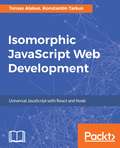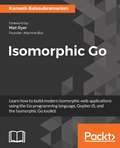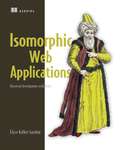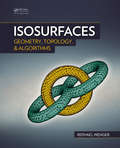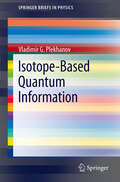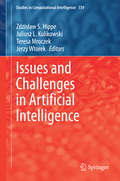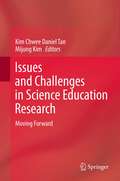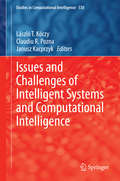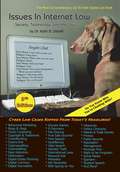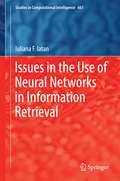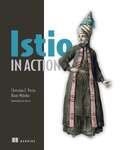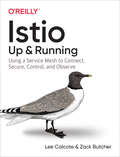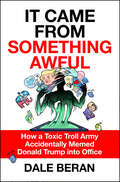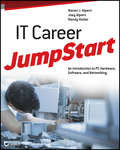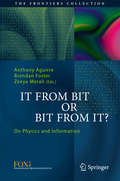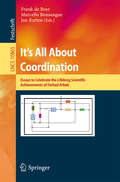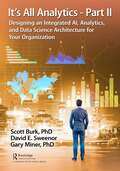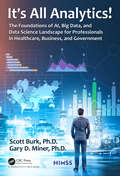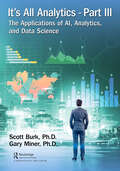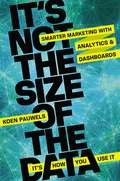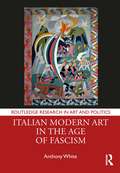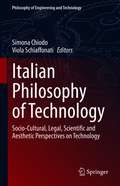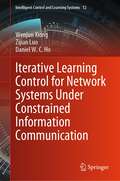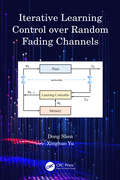- Table View
- List View
Isomorphic Application Development with JavaScript
by Konstantin TarkusLeverage the power of React and Node to build complete web applications in pure JavaScriptAbout This BookCombine the ease of React in the front end with the power of Node at the back end to build robust apps in pure JavaScriptGet your hands dirty by building on an entire application throughout the course of the bookBecome productive and save precious time by adopting isomorphic JavaScript programming techniquesWho This Book Is ForThis book is ideally meant for intermediate web developers who are interested in building isomorphic applications using JavaScript.What You Will LearnBuild on the client side with the awesomeness of ReactStyle your application effectivelyRender the server side using ReactImplement a GraphQL server based on Node, Express, and SQLFetch application data using RelayBuild an isomorphic router to use in the applicationDeploy your application to a cloud hostSecure your application with a solid token-based authentication systemIn DetailThe latest trend in web development, Isomorphic JavaScript, allows developers to overcome some of the shortcomings of single page applications by running the same code on the server as well as on the client. Leading this trend is React, which when coupled with Node, allows developers to build JavaScript apps that are much faster and more SEO-friendly than single page applications.This book will begin by showing you how to develop front-end components in React. It will then show you how to bind these components to the back-end web services that leverage the power of Node. You'll see how web services can be used with React code to offload and maintain the application logic. By the end of this book, you will be able to save a significant amount of development time by learning to combine React and Node to code fast, scalable apps in pure JavaScript.
Isomorphic Go: Learn how to build modern isomorphic web applications using the Go programming language, GopherJS, and the Isomorphic Go toolkit
by Kamesh Balasubramanian Veena KameshKey Features Learn how to build Isomorphic Go web applications Neatly organize your isomorphic codebase to enhance the maintainability of your application Leverage the same Go code across the web server and the web browser Book Description Isomorphic Go is the methodology to create isomorphic web applications using the Go programming language. Isomorphic web applications have the capability to reuse code across environments, increasing the synergy between the web server and the web browser. This book is a hands-on guide that will show you how to build and deploy an Isomorphic Go web application. Isomorphic Go begins with an in-depth exploration of the benefits provided by the isomorphic web application architecture. You'll be introduced to the Isomorphic Go toolchain, and how it can help you write Go code that functions across environments. You'll learn how to create Go programs in the web browser using GopherJS and how to render isomorphic templates. Then you'll be introduced to end-to-end application routing, use isomorphic handoff to seamlessly transition state from the web server to the web browser, and compose isomorphic forms that have the ability to reuse form validation logic. You'll be exposed to advanced concepts including the implementation of real-time web application functionality with websockets and the creation of reusable components (cogs) that are rendered using the virtual DOM. Finally, you'll see how to deploy an Isomorphic Go web application to a production environment. What you will learn Create Go programs inside the web browser using GopherJS Render isomorphic templates on both the client side and the server side Perform end-to-end application routing for greater search engine discoverability and an enhanced user experience Implement isomorphic handoff to seamlessly transition state between the web server and the web browser Build real-time web application functionality with websockets Create reusable components (cogs) that are rendered using the virtual DOM Deploy an Isomorphic Go application for production use
Isomorphic Web Applications: Universal Development with React
by Elyse GordonSummaryIsomorphic Web Applications teaches you to build production-quality web apps using isomorphic architecture. Designed for working developers, this book offers examples in relevant frameworks like React, Redux, Angular, Ember, and webpack.Purchase of the print book includes a free eBook in PDF, Kindle, and ePub formats from Manning Publications.About the TechnologyBuild secure web apps that perform beautifully with high, low, or no bandwidth. Isomorphic web apps employ a pattern that exploits the full stack, storing data locally and minimizing server hits. They render flawlessly, maximize SEO, and offer opportunities to share code and libraries between client and server.About the BookIsomorphic Web Applications teaches you to build production-quality web apps using isomorphic architecture. You'll learn to create and render views for both server and browser, optimize local storage, streamline server interactions, and handle data serialization. Designed for working developers, this book offers examples in relevant frameworks like React, Redux, Angular, Ember, and webpack. You'll also explore unique debugging and testing techniques and master specific SEO skills. What's InsideControlling browser and server user sessions Combining server-rendered and SPA architecturesBuilding best-practice React applicationsDebugging and testingAbout the ReaderTo benefit from this book, readers need to know JavaScript, HTML5, and a framework of their choice, including React and Angular.About the AuthorElyse Kolker Gordon runs the growth engineering team at Strava. Previously, she was director of web engineering at Vevo, where she regularly solved challenges with isomorphic apps.Table of ContentsPART 1 - FIRST STEPSIntroduction to isomorphic web application architectureA sample isomorphic appPART 2 - ISOMORPHIC APP BASICSReact overviewApplying ReactTools: webpack and BabelReduxPART 3 - ISOMORPHIC ARCHITECTUREBuilding the serverIsomorphic view renderingTesting and debuggingHandling server/browser differences 203Optimizing for productionPART 4 - APPLYING ISOMORPHIC ARCHITECTURE WITH OTHER TOOLSOther frameworks: implementing isomorphic without ReactWhere to go from here
Isosurfaces: Geometry, Topology, and Algorithms
by Rephael WengerEver since Lorensen and Cline published their paper on the Marching Cubes algorithm, isosurfaces have been a standard technique for the visualization of 3D volumetric data. Yet there is no book exclusively devoted to isosurfaces. Isosurfaces: Geometry, Topology, and Algorithms represents the first book to focus on basic algorithms for isosurface co
Isotope-Based Quantum Information
by Vladimir G. PlekhanovThe present book provides to the main ideas and techniques of the rapid progressing field of quantum information and quantum computation using isotope - mixed materials. It starts with an introduction to the isotope physics and then describes of the isotope - based quantum information and quantum computation. The ability to manipulate and control electron and/or nucleus spin in semiconductor devices provides a new route to expand the capabilities of inorganic semiconductor-based electronics and to design innovative devices with potential application in quantum computing. One of the major challenges towards these objectives is to develop semiconductor-based systems and architectures in which the spatial distribution of spins and their properties can be controlled. For instance, to eliminate electron spin decoherence resulting from hyperfine interaction due to nuclear spin background, isotopically controlled devices are needed (i.e., nuclear spin-depleted). In other emerging concepts, the control of the spatial distribution of isotopes with nuclear spins is a prerequisite to implement the quantum bits (or qbits). Therefore, stable semiconductor isotopes are important elements in the development of solid-state quantum information. There are not only different algorithms of quantum computation discussed but also the different models of quantum computers are presented. With numerous illustrations this small book is of great interest for undergraduate students taking courses in mesoscopic physics or nanoelectronics as well as quantum information, and academic and industrial researches working in this field.
Issues and Challenges in Artificial Intelligence
by Zdzisław S. Hippe Juliusz L. Kulikowski Teresa Mroczek Jerzy WtorekThe importance of human-computer system interaction problems is increasing due to the growing expectations of users on general computer systems capabilities in human work and life facilitation. Users expect system which is not only a passive tool in human hands but rather an active partner equipped with a sort of artificial intelligence, having access to large information resources, being able to adapt its behavior to the human requirements and to collaborate with the human users. This book collects examples of recent human-computer system solutions. The content of the book is divided into three parts. Part I is devoted to detection, recognition and reasoning in different circumstances and applications. Problems associated with data modeling, acquisition and mining are presented by papers collected in part II and part III is devoted to Optimization.
Issues and Challenges in Science Education Research
by Mijung Kim Kim Chwee TanIn contemporary society, science constitutes a significant part of human life in that it impacts on how people experience and understand the world and themselves. The rapid advances in science and technology, newly established societal and cultural norms and values, and changes in the climate and environment, as well as, the depletion of natural resources all greatly impact the lives of children and youths, and hence their ways of learning, viewing the world, experiencing phenomena around them and interacting with others. These changes challenge science educators to rethink the epistemology and pedagogy in science classrooms today as the practice of science education needs to be proactive and relevant to students and prepare them for life in the present and in the future. Featuring contributions from highly experienced and celebrated science educators, as well as research perspectives from Europe, the USA, Asia and Australia, this book addresses theoretical and practical examples in science education that, on the one hand, plays a key role in our understanding of the world, and yet, paradoxically, now acknowledges a growing number of uncertainties of knowledge about the world. The material is in four sections that cover the learning and teaching of science from science literacy to multiple representations; science teacher education; the use of innovations and new technologies in science teaching and learning; and science learning in informal settings including outdoor environmental learning activities. Acknowledging the issues and challenges in science education, this book hopes to generate collaborative discussions among scholars, researchers, and educators to develop critical and creative ways of science teaching to improve and enrich the lives of our children and youths.
Issues and Challenges of Intelligent Systems and Computational Intelligence
by Janusz Kacprzyk László T. Kóczy Claudiu R. PoznaThis carefully edited book contains contributions of prominent and active researchers and scholars in the broadly perceived area of intelligent systems. The book is unique both with respect to the width of coverage of tools and techniques, and to the variety of problems that could be solved by the tools and techniques presented. The editors have been able to gather a very good collection of relevant and original papers by prominent representatives of many areas, relevant both to the theory and practice of intelligent systems, artificial intelligence, computational intelligence, soft computing, and the like. The contributions have been divided into 7 parts presenting first more fundamental and theoretical contributions, and then applications in relevant areas.
Issues in Internet Law: Society, Technology, and the Law (Ninth Edition)
by Keith B. DarrellThis book provides a concise overview of Internet law updated with the latest cases and trends.
Issues in the Use of Neural Networks in Information Retrieval
by Iuliana F. IatanThis book highlights the ability of neural networks (NNs) to be excellent pattern matchers and their importance in information retrieval (IR), which is based on index term matching. The book defines a new NN-based method for learning image similarity and describes how to use fuzzy Gaussian neural networks to predict personality. It introduces the fuzzy Clifford Gaussian network, and two concurrent neural models: (1) concurrent fuzzy nonlinear perceptron modules, and (2) concurrent fuzzy Gaussian neural network modules. Furthermore, it explains the design of a new model of fuzzy nonlinear perceptron based on alpha level sets and describes a recurrent fuzzy neural network model with a learning algorithm based on the improved particle swarm optimization method.
Istio in Action
by Christian E. Posta Rinor MalokuSolve difficult service-to-service communication challenges around security, observability, routing, and resilience with an Istio-based service mesh. Istio allows you to define these traffic policies as configuration and enforce them consistently without needing any service-code changes. In Istio in Action you will learn: Why and when to use a service mesh Envoy's role in Istio's service mesh Allowing "North-South" traffic into a mesh Fine-grained traffic routing Make your services robust to network failures Gain observability over your system with telemetry "golden signals" How Istio makes your services secure by default Integrate cloud-native applications with legacy workloads such as in VMs Reduce the operational complexity of your microservices with an Istio-powered service mesh! Istio in Action shows you how to implement this powerful new architecture and move your application-networking concerns to a dedicated infrastructure layer. Non-functional concerns stay separate from your application, so your code is easier to understand, maintain, and adapt regardless of programming language. In this practical guide, you'll go hands-on with the full-featured Istio service mesh to manage microservices communication. Helpful diagrams, example configuration, and examples make it easy to understand how to control routing, secure container applications, and monitor network traffic. About the technology Offload complex microservice communication layer challenges to Istio! The industry-standard Istio service mesh radically simplifies security, routing, observability, and other service-to-service communication challenges. With Istio, you use a straightforward declarative configuration style to establish application-level network policies. By separating communication from business logic, your services are easier to write, maintain, and modify. About the book Istio in Action teaches you how to implement an Istio-based service mesh that can handle complex routing scenarios, traffic encryption, authorization, and other common network-related tasks. You'll start by defining a basic service mesh and exploring the data plane with Istio&’s service proxy, Envoy. Then, you'll dive into core topics like traffic routing and visualization and service-to-service authentication, as you expand your service mesh to workloads on multiple clusters and legacy VMs. What's inside Comprehensive coverage of Istio resources Practical examples to showcase service mesh capabilities Implementation of multi-cluster service meshes How to extend Istio with WebAssembly Traffic routing and observability VM integration into the mesh About the reader For developers, architects, and operations engineers. About the author Christian Posta is a well-known architect, speaker, and contributor. Rinor Maloku is an engineer at Solo.io working on application networking solutions. ToC PART 1 UNDERSTANDING ISTIO 1 Introducing the Istio service mesh 2 First steps with Istio 3 Istio's data plane: The Envoy proxy PART 2 SECURING, OBSERVING, AND CONTROLLING YOUR SERVICE&’S NETWORK TRAFFIC 4 Istio gateways: Getting traffic into a cluster 5 Traffic control: Fine-grained traffic routing 6 Resilience: Solving application networking challenges 7 Observability: Understanding the behavior of your services 8 Observability: Visualizing network behavior with Grafana, Jaeger, and Kiali 9 Securing microservice communication PART 3 ISTIO DAY-2 OPERATIONS 10 Troubleshooting the data plane 11 Performance-tuning the control plane PART 4 ISTIO IN YOUR ORGANIZATION 12 Scaling Istio in your organization 13 Incorporating virtual machine workloads into the mesh 14 Extending Istio on the request path
Istio: Using a Service Mesh to Connect, Secure, Control, and Observe
by Lee Calcote Zack ButcherYou did it. You successfully transformed your application into a microservices architecture. But now that you’re running services across different environments—public to public, private to public, virtual machine to container—your cloud native software is beginning to encounter reliability issues.How do you stay on top of this ever-increasing complexity? With the Istio service mesh, you’ll be able to manage traffic, control access, monitor, report, get telemetry data, manage quota, trace, and more with resilience across your microservice.In this book, Lee Calcote and Zack Butcher explain why your services need a service mesh and demonstrate step-by-step how Istio fits into the life cycle of a distributed application. You’ll learn about the tools and APIs for enabling and managing many of the features found in Istio.Explore the observability challenges Istio addressesUse request routing, traffic shifting, fault injection, and other features essential to running a solid service meshGenerate and collect telemetry informationTry different deployment patterns, including A/B, blue/green, and canaryGet examples of how to develop and deploy real-world applications with Istio support
It Came from Something Awful: How a Toxic Troll Army Accidentally Memed Donald Trump into Office
by Dale BeranHow 4chan and 8chan fuel white nationalism, inspire violence, and infect politics.The internet has transformed the ways we think and act, and by consequence, our politics. The most impactful recent political movements on the far left and right started with massive online collectives of teenagers. Strangely, both movements began on the same website: an anime imageboard called 4chan.org. It Came from Something Awful is the fascinating and bizarre story of sites like 4chan and 8chan and their profound effect on youth counterculture.Dale Beran has observed the anonymous messageboard community's shifting activities and interests since the beginning. Sites like 4chan and 8chan are microcosms of the internet itself—simultaneously at the vanguard of contemporary culture, politics, comedy and language, and a new low for all of the above. They were the original meme machines, mostly frequented by socially awkward and disenfranchised young men in search of a place to be alone together.During the recession of the late 2000’s, the memes became political. 4chan was the online hub of a leftist hacker collective known as Anonymous and a prominent supporter of the Occupy Wall Street movement. But within a few short years, the site’s ideology spun on its axis; it became the birthplace and breeding ground of the alt-right. In It Came from Something Awful, Beran uses his insider’s knowledge and natural storytelling ability to chronicle 4chan's strange journey from creating rage-comics to inciting riots to—according to some—memeing Donald Trump into the White House.
It Career JumpStart
by Naomi J. Alpern Joey Alpern Randy MuellerA practical approach for anyone looking to enter the IT workforce Before candidates can begin to prepare for any kind of certification, they need a basic understanding of the various hardware and software components used in a computer network. Aimed at aspiring IT professionals, this invaluable book strips down a network to its bare basics, and discusses this complex topic in a clear and concise manner so that IT beginners can confidently gain an understanding of fundamental IT concepts. In addition, a base knowledge has been established so that more advanced topics and technologies can be learned over time. Includes a discussion of the key computer components, such as the processor and memory Covers the basics of data storage as well as the input/output process Zeroes in on basic hardware configuration including how to install hardware and software drivers Introduces various computer operating systems, including the Windows OS family, Linux, and Mac. Looks at basic networking concepts and design IT Career JumpStart is an ideal starting point for anyone looking for a career in IT but doesn't know where to start.
It From Bit or Bit From It?
by Anthony Aguirre Brendan Foster Zeeya MeraliThe essays in this book look at the question of whether physics can be based on information, or ? as John Wheeler phrased it ? whether we can get ?It from Bit'. They are based on the prize-winning essays submitted to the FQXi essay competition of the same name, which drew over 180 entries. The eighteen contributions address topics as diverse as quantum foundations, entropy conservation, nonlinear logic and countable spacetime. Together they provide stimulating reading for all physics aficionados interested in the possible role(s) of information in the laws of nature. The Foundational Questions Institute, FQXi, catalyzes, supports, and disseminates research on questions at the foundations of physics and cosmology, particularly new frontiers and innovative ideas integral to a deep understanding of reality, but unlikely to be supported by conventional funding sources.
It's All About Coordination: Essays Dedicated To Farhad Arbab On The Occasion Of His 65th Birthday (Theoretical Computer Science and General Issues #10865)
by Marcello Bonsangue Frank De Boer Jan RuttenThis Festschrift volume has been published to celebrate the lifelong scientific achievements of Farhad Arbab on the occasion of his retirement from the Centre of Mathematics and Computer Science (CWI).Over the years Farhad Arbab has sucessfully been engaged in scientific explorations in various directions: Software Composition, Service Oriented Computing, Component-based Software, Concurrency Theory, Coordination Models and Languages, Parallel and Distributed Computing, Visual Programming Environments, Constraints, Logic and Object-Oriented Programming.Farhad Arbab has shaped the field of Coordination Models and Languages. His insight that it is all about exeogeneous coordination gave rise to the striking elegance and beauty of Reo: an exogenous coordination model based on a formal calculus of channel composition. Reo has been extremely successful and is having a great impact in many of the areas mentioned above.The present volume collects a number of papers by several of Farhad’s close collaborators over the years.
It's All Analytics - Part II: Designing an Integrated AI, Analytics, and Data Science Architecture for Your Organization
by Gary Miner Scott Burk David SweenorUp to 70% and even more of corporate Analytics Efforts fail!!! Even after these corporations have made very large investments, in time, talent, and money, in developing what they thought were good data and analytics programs. Why? Because the executives and decision makers and the entire analytics team have not considered the most important aspect of making these analytics efforts successful. In this Book II of "It’s All Analytics!" series, we describe two primary things: 1) What this "most important aspect" consists of, and 2) How to get this "most important aspect" at the center of the analytics effort and thus make your analytics program successful. This Book II in the series is divided into three main parts: Part I, Organizational Design for Success, discusses ……. The need for a complete company / organizational Alignment of the entire company and its analytics team for making its analytics successful. This means attention to the culture – the company culture culture!!! To be successful, the CEO’s and Decision Makers of a company / organization must be fully cognizant of the cultural focus on ‘establishing a center of excellence in analytics’. Simply, "culture – company culture" is the most important aspect of a successful analytics program. The focus must be on innovation, as this is needed by the analytics team to develop successful algorithms that will lead to greater company efficiency and increased profits. Part II, Data Design for Success, discusses ….. Data is the cornerstone of success with analytics. You can have the best analytics algorithms and models available, but if you do not have good data, efforts will at best be mediocre if not a complete failure. This Part II also goes further into data with descriptions of things like Volatile Data Memory Storage and Non-Volatile Data Memory Storage, in addition to things like data structures and data formats, plus considering things like Cluster Computing, Data Swamps, Muddy Data, Data Marts, Enterprise Data Warehouse, Data Reservoirs, and Analytic Sandboxes, and additionally Data Virtualization, Curated Data, Purchased Data, Nascent & Future Data, Supplemental Data, Meaningful Data, GIS (Geographic Information Systems) & Geo Analytics Data, Graph Databases, and Time Series Databases. Part II also considers Data Governance including Data Integrity, Data Security, Data Consistency, Data Confidence, Data Leakage, Data Distribution, and Data Literacy. Part III, Analytics Technology Design for Success, discusses …. Analytics Maturity and aspects of this maturity, like Exploratory Data Analysis, Data Preparation, Feature Engineering, Building Models, Model Evaluation, Model Selection, and Model Deployment. Part III also goes into the nuts and bolts of modern predictive analytics, discussing such terms as AI = Artificial Intelligence, Machine Learning, Deep Learning, and the more traditional aspects of analytics that feed into modern analytics like Statistics, Forecasting, Optimization, and Simulation. Part III also goes into how to Communicate and Act upon Analytics, which includes building a successful Analytics Culture within your company / organization. All-in-all, if your company or organization needs to be successful using analytics, this book will give you the basics of what you need to know to make it happen.
It's All Analytics!: The Foundations of Al, Big Data and Data Science Landscape for Professionals in Healthcare, Business, and Government
by Gary D. Miner Scott BurkIt's All Analytics! The Foundations of AI, Big Data and Data Science Landscape for Professionals in Healthcare, Business, and Government (978-0-367-35968-3, 325690) Professionals are challenged each day by a changing landscape of technology and terminology. In recent history, especially in the last 25 years, there has been an explosion of terms and methods that automate and improve decision-making and operations. One term, "analytics," is an overarching description of a compilation of methodologies. But AI (artificial intelligence), statistics, decision science, and optimization, which have been around for decades, have resurged. Also, things like business intelligence, online analytical processing (OLAP) and many, many more have been born or reborn. How is someone to make sense of all this methodology and terminology? This book, the first in a series of three, provides a look at the foundations of artificial intelligence and analytics and why readers need an unbiased understanding of the subject. The authors include the basics such as algorithms, mental concepts, models, and paradigms in addition to the benefits of machine learning. The book also includes a chapter on data and the various forms of data. The authors wrap up this book with a look at the next frontiers such as applications and designing your environment for success, which segue into the topics of the next two books in the series.
It's All Analytics, Part III: The Applications of AI, Analytics, and Data Science
by Gary Miner Scott BurkProfessionals are challenged each day by a changing landscape of technology and terminology. In recent history, especially the last 25 years, there has been an explosion of terms and methods born that automate and improve decision-making and operations. One term, called "analytics," is an overarching description of a compilation of methodologies. But artificial intelligence (AI), statistics, decision science, and optimization, which have been around for decades, have resurged. Also, things like business intelligence, online analytical processing (OLAP) and many, many more have been born or reborn. How is someone to make sense of all this methodology, terminology? Extending on the foundations introduced in the first book, this book illustrates how professionals in healthcare, business, and government are applying these disciplines, methods, and technologies. The goal of this book is to get leaders and practitioners to start thinking about how they may deploy techniques outside their function or industry into their domain. Application of modern technology into new areas is one of the fastest, most effective ways to improve results. By providing a rich set of examples, this book fosters creativity in the application and use of AI and analytics in innovative ways.
It's Not the Size of the Data - It's How You Use It: Smarter Marketing with Analytics and Dashboards
by Koen PauwelsBrand tracking, CRM programs, trade shows, online behavior tracking, satisfaction studies. Mounds of marketing metrics are generated across touchpoints and channels. It can be information overload--too much, too scattered. But locked in the vast quantity of information are accurate, data-driven answers to every marketing question. Analytic dashboards are transformative web-based tools that gather, syn the size, and visually display essential data in real time, directly connecting marketing with performance. World renowned marketing expert Koen Pauwels supplies a simple yet rigorous methodology and wealth of case studies to help any size organization, in any industry, turn data into productive action. He explains step by step how to: Gain crucial IT support Build a rock-solid database Select key leading performance indicators Design the optimal dashboard layout Use marketing analytics to improve decisions and reap rewards Gut decisions are outdated and downright dangerous. Whether you're trying to allocate resources between online and offline marketing, measure the ROI of specific efforts, or scale up a creative campaign, dashboard analytics bring scientific precision and insight to marketing efforts--with far better results.
It's a Book
by Lane SmithPlayful and lighthearted with a subversive twist that is signature Lane Smith, IT’S A BOOK is a delightful manifesto on behalf of print in the digital age. This satisfying, perfectly executed picture book has something to say to readers of all stripes and all ages.
Italian Modern Art in the Age of Fascism (Routledge Research in Art and Politics)
by Anthony WhiteThis book examines the work of several modern artists, including Fortunato Depero, Scipione, and Mario Radice, who were working in Italy during the time of Benito Mussolini’s rise and fall. It provides a new history of the relationship between modern art and fascism. The study begins from the premise that Italian artists belonging to avant-garde art movements, such as futurism, expressionism, and abstraction, could produce works that were perfectly amenable to the ideologies of Mussolini’s regime. A particular focus of the book is the precise relationship between ideas of history and modernity encountered in the art and politics of the time and how compatible these truly were.
Italian Philosophy of Technology: Socio-Cultural, Legal, Scientific and Aesthetic Perspectives on Technology (Philosophy of Engineering and Technology #35)
by Viola Schiaffonati Simona ChiodoThis is the first volume about the Italian philosophy of technology written in English and including novel and translated contributions. The volume presents original research on emerging topics in the field, as well as an overview of the most distinguished Italian approaches to the philosophy of technology. While offering both historical and political perspectives and the contributions of the philosophy of law, philosophy of science, and aesthetics, Italian Philosophy of Technology promotes a novel view on the intersection between continental and analytic traditions in the philosophy of technology.
Iterative Learning Control for Network Systems Under Constrained Information Communication (Intelligent Control and Learning Systems #12)
by Daniel W. Ho Wenjun Xiong Zijian LuoThis book focuses on the subject area of Network Systems and Control Theory, providing a comprehensive examination of the dynamic behavior of networked systems operating under communication constraints. It introduces innovative iterative learning control strategies that aim to ensure stability, consistency, and security of networked systems. The field of networked systems has garnered significant interest from scientists and engineers across various disciplines, including information, electrical, transportation, life, social, and management sciences. This book consistently addresses a wide range of issues related to networked systems, emphasizing the critical impact of communication constraints on stability and security. It highlights the effectiveness and importance of iterative learning methods in tackling these challenges.Suitable for both undergraduate and graduate students interested in networked systems and iterative learning control, this book alsoserves as a valuable resource for university faculty and engineers engaged in complex systems, control theory research, and real-world applications. Its broad appeal extends to professionals working in related fields, seeking a deeper understanding of networked systems and their control mechanisms.
Iterative Learning Control over Random Fading Channels
by Xinghuo Yu Dong ShenRandom fading communication is a type of attenuation damage of data over certain propagation media. Establishing a systematic framework for the design and analysis of learning control schemes, the book studies in depth the iterative learning control for stochastic systems with random fading communication. The authors introduce both cases where the statistics of the random fading channels are known in advance and unknown. They then extend the framework to other systems, including multi-agent systems, point-to-point tracking systems, and multi-sensor systems. More importantly, a learning control scheme is established to solve the multi-objective tracking problem with faded measurements, which can help practical applications of learning control for high-precision tracking of networked systems. The book will be of interest to researchers and engineers interested in learning control, data-driven control, and networked control systems.
